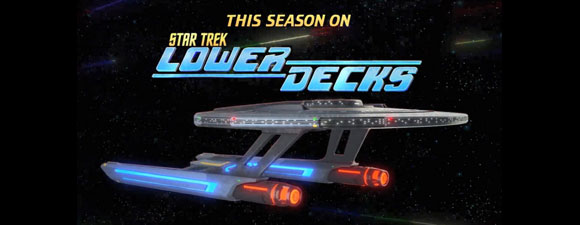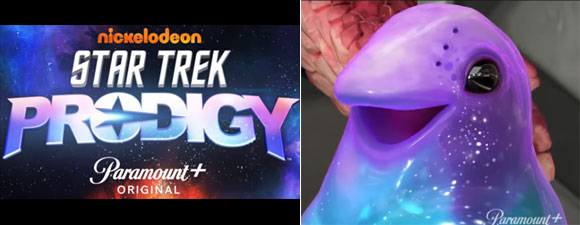Critical Care
By Edward James HinesPosted at November 12, 2000 - 6:31 PM GMT
"Critical Care" ***
Teleplay by James Kahn
Story by Kenneth Biller & Robert Doherty
Directed by Terry Windell
Captain's Log
While trading high-grade iridium ore with Voyager, a Dralian "snake oil salesman" named Gar (John Kassir) steals the Doctor's mobile emitter and sells it to Chellick (Larry Drake), administrator of a hospital ship on the D'Nali home world. Aboard Voyager, B'Elanna Torres discovers a fake mobile emitter while Tom Paris and Harry Kim find one of the Doctor's old training programs running in Sickbay. Janeway orders Voyager to follow Gar's ion trail and retrace his steps until they find the Doctor.
Meanwhile, the real Doctor discovers that medical care aboard the alien hospital ship is determined by social status. The Allocator is a sophisticated computer that derives an individual's treatment coefficient (TC) by using a complex formula composed of profession, skills and accomplishments. The more critical an individual's job and abilities are to the survival of society, the higher his or her TC is. In essence, the Allocator "assesses the entire individual and reduces his life to a number."
Needless to say, this kind of preferential treatment does not sit well with the Doctor. He begins helping low-TC patients on Level Red, a minor care facility that hasn't the necessary resource allocations to cure truly ill people. He is particularly taken with Tebbis (Dublin James), a young, friendly, compassionate patient with ambitions to be a doctor but stricken by a deadly chromo-viral infection. He cannot get the necessary cytoglobin treatments because his TC is too low. The Doctor tries to artificially elevate Tebbis' TC by amending his database with false skills, but to no avail.
When the Doctor is transferred up to Level Blue, which is a cleaner, more high-tech facility reserved for patients with the highest TCs, he learns that cytoglobin injections are routinely administered on this level to prevent arterial aging and raise life expectancy. He clandestinely acquires several of these injections and distributes them to Level Red's needy patients, including Tebbis. The boy's condition begins to improve, but then he is suddenly struck down by a secondary infection, which goes untreated because of his low TC.
The Doctor angrily confronts Chellick, who has learned about the unauthorized injections. His attitude is that Tebbis would have survived if he had been fit enough, and he orders all Level Red patients who have benefited from the Doctor's illicit activities to be sent home. To punish the Doctor, Chellick interfaces his holomatrix with the Allocator, which will restrict the Doctor's movements and regulate his activities.
Undaunted, the Doctor enlists the help of another physician, Voje (Paul Scherrer), in smuggling his mobile emitter to Level Red, where he tries to save those patients who are being sent home. When Chellick finds and threatens to deactivate him, the Doctor injects Chellick with the same chromo-virus that afflicted Tebbis. In exchange for enough cytoglobin to cure everyone on Level Red, the Doctor will save Chellick. The administrator reluctantly agrees. Voyager soon arrives and rescues the Doctor.
Personal Log
The last time I got really stuck when writing a VGR review was at the tail end of last season with "Fury," which came just before the second Barclay/Troi episode, "Life Line." I held off watching "Life Line" for several days while I struggled to make sense of the ferocious mess that was "Fury." I soon tired of trying to untangle this knot and just popped in "Life Line," and I also watched the two remaining episodes of S6 without having finished figuring out "Fury." It was several more weeks before that finally happened.
And now, here I am again, stumped by "Critical Care" for over a week while my VHS copy of the next Barclay/Troi episode, "Inside Man," sits unwatched on my shelf. I like the stories that focus on Starfleet's efforts to help Voyager, but sheesh! Every time they show one, I can't watch it until I figure out what happened the week before!
"Critical Care" is by no means as disorderly as "Fury," but it also isn't as amazing as it pretends to be. To tout its "superiority" weeks before it was shown, my UPN station's newscast showed a special featurette in which actor Robert Picardo described "Critical Care" as "the Doctor vs. the HMO." Somebody at Paramount probably figured, "Oooo, it's an election year and both candidates are harping about healthcare. Let's get people to want to watch this show before they go to the polls, and we'll have a hit on our hands for being hip to the cause!" Unfortunately, "Critical Care" was about as illuminating as the outcome of the presidential election (at this writing). What was the hubbub all about?
Ranting aside, I genuinely enjoyed "Critical Care." It was solidly written and performed. It was an effective morality play. It should be remembered as one of VGR's standout episodes. My problem was that I allowed the advance hype to stymie me and my timely review, just as with "Fury." I was looking too hard to find more hidden meaning in this episode when, in fact, it was as straightforward as can be.
Supplemental
In the best tradition of classic Star Trek, "Critical Care" addresses the current social issue of health management, complete with references to tedious paperwork and endless delays. The Doctor's encounter with a computer that is directing an alien society is similar to several TOS scenarios. Just as his freedom and the well-being of his patients are jeopardized, so too were Captain Kirk and his ship/crew imperiled in such episodes as "The Return of the Archons," "A Taste of Armageddon" and "The Apple." The only difference seems to be that the Doctor doesn't destroy the Allocator computer at the end of "Critical Care," as was Kirk's signature cap in his day.
EMH Ethics
The Doctor's actions inevitably raise the question of morality. Is he violating the Prime Directive? Is he violating his Hippocratic oath to "do no harm" when he deliberately poisons Chellick? Are his actions, including lying and stealing, justified?
Do we really need to answer these questions? "Critical Care" is designed to eventually exonerate the Doctor. This is an "ends justify the means" show, right down to Chakotay, Torres and Dysek (Gregory Itzin) arriving just in time to back up the Doctor's efforts. He identifies his crusade obtaining cytoglobin injections for the dozen needy patients on Level Red and does whatever is necessary to make it happen. In the final scene, however, he hopes that he can chalk up his "aberrant" behavior to a malfunction in his ethical subroutines. Seven of Nine cannot comfort him with an affirmative, but realistically, it doesn't matter. Unlike the aftermath of shows like "Retrospect" and the poignant "Latent Image," the Doctor will not be losing any sleep over the choices he made in "Critical Care." He would never have allowed Chellick to die. If the situation had become more critical, he would have saved Chellick and still found a way to save the other patients.
However, it is important to note that just because we viewers consider the Doctor's actions to be "right" does not make Chellick's position wrong. Chellick was specifically contracted to serve the needs of a whole society by making difficult decisions with limited resources, which is why his Darwinian attitude comes in handy. Even Dysek freely admits that his planet is better off since it began following the Allocator's protocols. The alternative, as far as he is concerned, is a return to more eco-disasters and famine.
In the end, it is also important to note that just because Dysek appreciates the Doctor's efforts to show him the intricacies of Chellick's system does not mean that the Allocator will be shut down. The Doctor does not enjoy a great moral victory over these people. Certainly, there may be questions asked by Dysek and Voje and others whom the Doctor may have influenced regarding the inequality of the TC system, but ultimately, they will probably find ways of working within the system or even around it, assuming they were attentive to some of the Doctor's trickery.
"Educational" EMH?
Of course, the Doctor's actions aren't all about trickery. It is especially interesting to watch him trying to teach Voje, who, in his young career, knows only how to work by the rules and within the system. He doesn't rock the boat. He is quick to give up "There's nothing you can do" being his favored line whenever his job encroaches on the limits of the Allocator's protocols.
Working within these limits, perhaps the best advice the Doctor gives Voje about treating patients is summarized by the questions, "What can I do? What must I do?" The ultimate objective of "saving lives" doesn't appear to be the imperative of Voje's society. We must consider that just because Federation doctors believe in the sanctity of life does not mean that non-Federation doctors follow the same practice. Voje's people, given their cataclysmic history, appear to be a case in point.
Unfortunately, the Doctor's example leaves Voje terribly confused about what physicians are actually supposed to do save lives or use them for leverage? At first, the Doctor makes Voje excited about the former: "That feeling you get from healing someone. Infectious, isn't it?" Later, however, the Doctor goes and spoils it all by doing something stupid like purposefully infecting Chellick right in front of Voje. What is the young man to believe?
It is interesting to note that when Voje's livelihood is thus threatened, he retreats back into the system, which is all he really knows, and calls on his superior, Dysek, to resolve the situation with Chellick. Dysek, however, when his livelihood is threatened by the possibility of dwindling supplies and demotion, chooses to follow the Doctor's example and work outside the system, having the dozen Level Red patients (plus Chellick) transferred to Level Blue under the ruse of being treated for "arterial aging."
History Repeating
The nitwit scenario of the Doctor being abducted is certainly not new to VGR (see "Future's End, Part II" and "Living Witness"). The setup for this debacle is at least plausible, with Gar spending the night in Sickbay for "food poisoning" while the Doctor amiably bubbles over with details about his mobile emitter. The rest is utter garbage. You would think that, by now, security protocols regarding Delta Quadrant visitors would be so complex as to border on inhospitable. Why isn't there some sort of compulsory scan or manual frisk conducted before they are allowed to leave Voyager or, at the very least, a routine accounting of all critical Voyager systems? Can anyone do this job?
Woe to the actor who is cast as a Star Trek security chief, because under the current writing regime, his or her character will nearly always be the worst at the job. It has become a convenient Star Trek crutch for Starfleet security officers to be lax. As with the often-fluctuating state of Starfleet's medical knowledge, security effectiveness is only as good as the story allows it to be. There is no rhyme or reason. Tuvok has dropped the ball too many times to count ("Maneuvers" being one of the most flagrant), and yet he received a promotion for his "good" work ("Revulsion") instead of more deserving characters like Harry Kim. Go figure. At least, in "Critical Care," Tuvok has the good sense to appear contrite when Janeway scolds him.
Also, it simply makes no sense that the Doctor is regarded as a "low-security file," or that he is allowed to chatter away indiscriminately to any common stranger about the intricacies of his program. His security rating needs to be bumped up to maximum and Torres needs to get in there and wire shut the Doctor's mouth for whenever the next "trader" stops by with stomach pains.
Details, Details
Tuvok really has no idea how good he has it. No sooner does Janeway reprimand him for not doing his job than Neelix steps forward to take the blame for Gar being in Sickbay in the first place. Particularly amusing later on is the scene in the brig with both Tuvok and Neelix trying to encourage Gar to talk. It is so well-played that is seems staged, with Neelix stepping up just as Tuvok's mind-meld threat fizzles.
Actually, on further consideration, Tuvok has things twice as good. First, he pisses off his captain, and then he gets to be her "man" for a few moments as part of a ruse to locate Gar. This also is a nicely played, light scene in an otherwise serious episode.
Paris and Kim's latest holodeck endeavor is hockey, which comes a bit late in the VGR game. It almost seems like the producers are trying too hard to turn these guys into DS9's famously fast friends O'Brien and Bashir, who also shared various holodeck adventures together and could often be seen traipsing about in strange, period clothing.
On the production side of things, "Critical Care" boasts several breathtaking visual effects of the alien cityscape and hospital ship, the most expansive of which is in the opening shot of the teaser (somewhat reminiscent of the Coruscant cityscape in Star Wars: Episode I The Phantom Menace). Over in the makeup department, Chellick is outfitted with Bolian-style earlobes.
Familiar Faces
Gregory Itzin ("Dysek") is a two-time DS9 veteran, having played "Ilon Tandro" in "Dax" and the humorous "Hain" in "Who Mourns for Morn?"
John Durbin ("Alien Miner") is a three-time TNG veteran, having played the Selay ambassador "Ssestar" in "Lonely Among Us" and the Cardassian "Gul Lemec" in "Chain of Command, Parts I and II." He also played "Traidy" in DS9's "A Simple Investigation."
Debi A. Monahan ("Adulteress") was "Melissa" from Vic Fontaine's lounge in DS9's "His Way."
Finally, the voice of the Allocator sounds familiar, like either Daniel Dae Kim from "Blink of an Eye" or the voice of Pralor Automated Personnel Unit 3947 from "Prototype."
Copyright Edward James Hines
11 November 2000
Edward James Hines writes weekly reviews of Voyager episodes.



